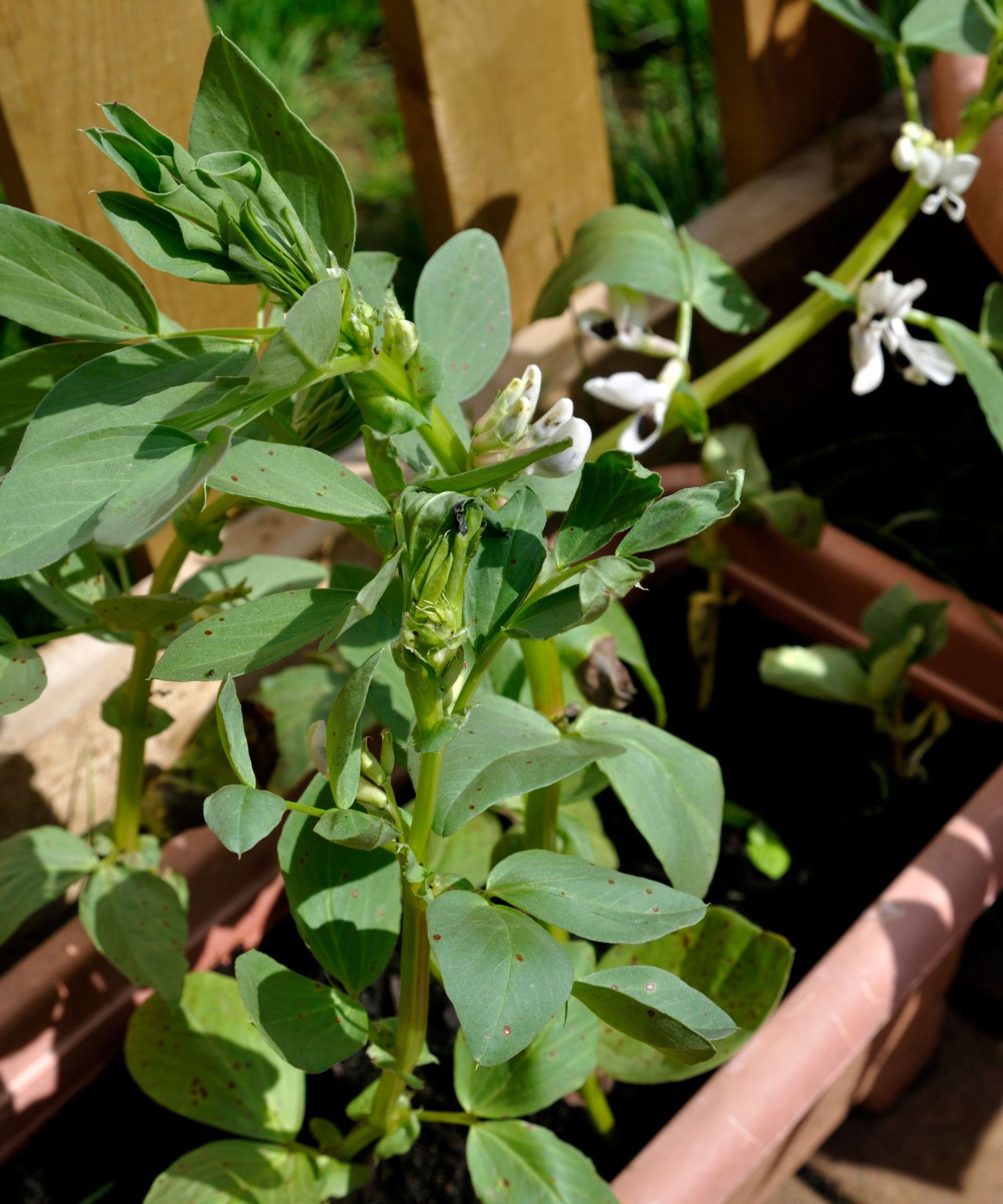My favorite tactics for growing fava beans in containers will give you lots of successful crops
With just a little expert know-how you can grow fava beans in pots and enjoy a bountiful harvest
- (opens in new tab)
- (opens in new tab)
- (opens in new tab)
- Sign up to our newsletter Newsletter


Fava beans are a tasty and fast-growing crop that can easily be grown in pots. Knowing how to grow fava beans in containers means you can enjoy succulent homegrown beans in even a small space.
Fava beans, also known as broad beans, come in various sizes and colors. The dwarf cultivars are mainly suitable for pots, though that should not put a damper on your ambitions. The beans can be eaten raw or cooked in many different ways. Indeed, young pods can be eaten whole and even the leaves are edible.
There are many methods for growing fava beans and all are applicable for growing in pots or containers. I have grown fava beans every year in my kitchen gardens. It was always a popular crop both with the chefs I grew for and the pods flew off the market stall when I sold vegetables to the public.

There are usually four or five beans per fava bean pod

Drew is a former professional gardener who has grown vegetables in several productive walled gardens. He supplied vegetables, fruit and herbs to chefs and also sold harvests to the public via a small market stall while working in the walled garden at Hanbury Hall in the UK.
Best methods for growing fava beans in containers
When considering the best options for planting fava beans, there are a few key choices available, and each have pros and cons. All these methods work in containers, and whichever one you choose will depend on your climate and the variety of fava bean you wish to grow.
1. Sow seeds indoors in winter
I have always tended to sow my fava beans indoors during winter before planting them outside in the kitchen garden when spring comes around. Personally, I found this to be a consistent and reliable method of growing the crop.
Sow one bean in modules or pots, pushing the bean 2 inches deep into compost and watering gently. Any modules or pots need to be deep as fava beans will grow roots quickly and they need space in which to develop before becoming root-bound.
Keep them somewhere where there is a lot of light and where the temperature is around 49-59˚F for the seed to germinate and grow on.
Growing fava beans in too high a temperature during winter can result in leggy growth and tall plants are more prone to be damaged when planted outside. I fell foul of this, growing them in a heated greenhouse for too long, finding it better to grow them in an unheated greenhouse or cold frame. This way you get sturdy and healthy plants ready to be planted outside.
If you do start the plants in a heated greenhouse, move them somewhere with cooler temperatures once the seeds have germinated to prevent the plants becoming overly-leggy. Plant the seedlings out into your chosen container in spring, or alternatively pot them into the container and keep it somewhere cool until the time comes to move it into its final position.

Fava bean seedlings need deep pots for their developing roots
2. Sow direct in your outdoor container in fall or spring
Planting fava beans direct into outdoor containers can be done in two windows during the year. The beans can be sown from mid-fall to early winter in milder and sheltered areas. Fava beans need only a minimum of 45˚F to germinate. Even if you live in an area that can provide that level of temperature, there remains the risk of water-logging and the seeds rotting in cold and sodden soil in a container.
Fava bean plants are hardy and can withstand frost, though seedlings need to be at least 1 inch tall before the worst of the winter weather hits in order to survive. Another issue with fall sowings is rodents eating the beans as they search for winter food, this can be prevented by covering the pots with wire or mesh to keep the critters at bay.
Planting fava beans in fall can mean an earlier crop, though often it will mean beans just a few weeks earlier than spring crops even though they were sown many months before. However, Lucy Chamberlain, vegetable expert for Amateur Gardening, sings the praises of fall-sown fava beans, hailing the ‘huge yields’ the plants give due to their ‘supremely advanced root system’.
‘I’ve carried out numerous trials of fall versus spring sowings. Fall sowings, if successful, give bigger yields,’ says Lucy. ‘To be successful, it’s important to choose suitable varieties with sufficient winter hardiness. You must also have free-draining soil – if you don’t, stick to spring sowings.’
The alternative is to sow fava beans outdoors in pots from late winter to mid-spring. When sowing direct either in fall or spring, gently push the seed 2 inches into the compost at a spacing of at least 8 inches apart.
When planting fava beans in the ground, you always plant them in staggered rows – this way the plants can help support each other as they grow. When growing fava beans in containers, follow the same principles and avoid planting them side by-side in one row or square pattern. Stagger them as best you can in your chosen container, though admittedly this may be easier in longer trough-style outdoor planters than in circular pots.

Sow one fava bean seed per pot when propagating plants
How deep should a container be for fava beans?
When thinking of vegetable garden container ideas, always consider the size of a plant's roots. Any pot or container for growing fava beans needs to be deep, as they are plants that do have a lengthy root system. The minimum depth of any pot or container should be 12 inches deep. Even the dwarfing varieties of fava beans produce roots that can hit those depths.
The container needs to be of ample size to allow the roots to grow and not become pot bound. Root bound plants can show signs of stress and can be at risk of diseases. In addition, a mass of roots taking up lots of space in a pot dramatically reduces the amount of room in there for water to be held. Ensure that the pot has good drainage holes in the base for excess water to escape.

Troughs are ideal containers to grow fava beans in
What is the best location and soil for container-grown fava beans?
Fava beans prefer a fertile soil that drains well. A free-draining soil is particularly vital if you are planting fava beans in containers in fall. If the pot sits water-logged over winter it increases the risk of the bean not germinating or rotting completely.
When planting fava beans in containers mix in some well-rotted manure, compost, or organic matter at a rate of one-third to two-thirds of soil. Place the container somewhere with full sun or partial shade and in a location that is protected from strong winds.

Fava beans can either be cooked or eaten raw in salads
How to care for fava beans growing in pots
Fava beans growing in containers will need regular watering to keep them moist. Ensure to regularly check pots as they lose moisture quicker then soil in the ground. Check at a minimum every other day to make sure the soil does not dry out and increase these checks during periods of warm weather. Timing is important when it comes to when to water plants. The plants will need a good soak and do not always presume that just because it rained the soil in the pots will be wet.
If you mixed in manure or organic matter into the soil prior to planting, then it is unnecessary to add any extra fertilizer to the pot during the growing season. As legumes, fava beans add nitrogen into the soil so any extra fertilizer that is added should be high in potassium, like this All-Natural Muriate of Potash fertilizer, available from Amazon (opens in new tab). Such a feed can be added just before the plant starts producing flowers. This will halt leaf growth and encourage the production of flowers and bean pods.
When the first young fava bean pods appear on the plant’s lowest truss of flowers, it is time to pinch out the top of the plant. Pinching out the tip redirects the plants energy and encourages fruiting and also reduces the risk of an infestation of blackfly – which are attracted to the tips.

The average fava bean plant can produce up to 20 pods
What are the best fava beans for growing in containers?
The ideal varieties of fava beans to grow in containers are the dwarf varieties that are available. These, including the likes of ‘Robin Hood’ and ‘The Sutton’, are compact cultivars that will grow to only 12-18 inches tall. This makes them much more suitable for pots than the larger varieties that will grow up to 40 inches tall. These compact cultivars can also mature quicker than larger varieties.
When it comes to how to support plants, if you are growing dwarf varieties then they do not need supporting. These cultivars will grow bushy rather than straight and tall. This leaves them less susceptible to being damaged from winds and requiring support to prevent them from collapsing due to their weight.
How long does it take to grow fava beans in pots?
Fava beans commonly take around three months to mature. It is dependent on when the beans were sowed, temperature, and location, though typically it is 80-100 days to go from sowing the seed to a first harvest of delicious fava beans.

Drew’s passion for gardening started with growing vegetables and salad in raised beds in a small urban terrace garden. He has gone on to work as a professional gardener in historic gardens across the UK and also specialise as a kitchen gardener growing vegetables, fruit, herbs, and cut flowers. That passion for growing extends to being an allotmenteer, garden blogger, and producing how-to gardening guides for websites.
-
-
 Robert Pattinson just bought a Spanish Colonial-style home – with an interior designer past
Robert Pattinson just bought a Spanish Colonial-style home – with an interior designer past'The Batman's' Robert Pattinson and Suki Waterhouse purchased the Jeff Lewis-designed Hollywood Hills estate for $5.3 million
By Megan Slack • Published
-
 7 expert-approved methods to remove candle wax from carpet
7 expert-approved methods to remove candle wax from carpetCleaning professionals share their tips on how to remove candle wax from carpet
By Millie Hurst • Published

